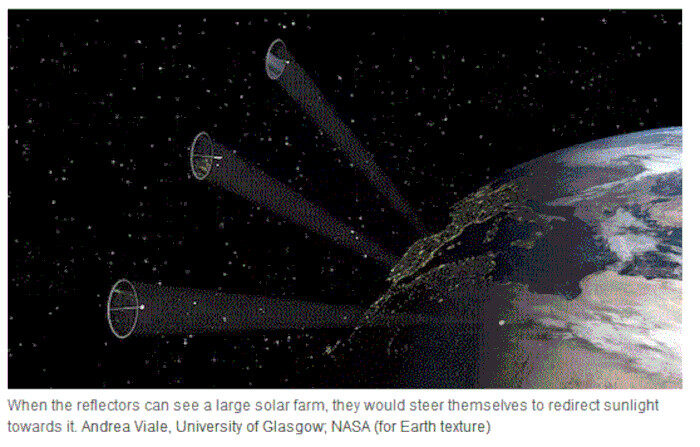We know it's corrupt when governments won't pay for research into the suns role in our climate but they'll give 2.5 million Euros to a wild idea that might rescue their banker and investment friends last technological white elephant. This was funded under "EXCELLENT SCIENCE - European Research Council (ERC)" don't you know?
They figure we could get teams of robots into space to assemble vast mirrors about 1 km across that would reflect the sun from 900km above Earth onto solar plants so they make electricity a bit more often. What could possibly go wrong, apart from mishaps that blind drivers, hurt wildlife, screw body clocks and waste gazillions of dollars?
As the huge reflectors pass over a solar plant, they will spin around and point at it to illuminate it "and it's immediate surroundings". Thus theoretically extending the working day of the solar panels, and delivering energy at breakfast and dinner time when the peak hour demand is killing our new fragile grids.
Supposedly when the plant on the ground rolls out of view, the giant mirrors will spin themselves edge on to the sun so they stop reflecting sunlight. Just imagine the maintenance nightmare and cost blowouts possible with large precision space infrastructure? Not to mention what happens when the software goes wrong, or hostile cyberhackers play "spot light" with highways, airports and military installations. How much fun can you have with a 10 kilometer wide beam? (That's just the inner intense core, the actual "stray light" could be an oval up to 70 km long.)
All the nasty surprises that make solar panels and wind farms so uneconomic on the planet would presumably multiply ten-fold in orbit as clouds get in the way, then solar flares and space junk damage the mirrors. How long will mirrors keep their smooth surface under the constant onslaught of the solar wind that runs at a million miles an hour?
Our supposedly best and brightest are publishing hallowed peer reviewed papers on frivolous new ways to rescue the low performing infrastructure that wasn't economic to build in the first place. The whole plan is to somehow improve the weather on Earth by reducing fossil fuel use, starting by burning tankerloads of fossil fuels to mine and launch kilotons of metal into space?
The ConversionWait for it:
Reflectors in space could make solar farms on Earth work for longer every day
Unlike proposals to build solar power stations in space and transmit energy down to earth, all the generation would still happen down here.
With the reflectors orbiting 900km above us - about twice the altitude of the International Space Station - we estimate that the illuminated area on the Earth would be approximately 10km across when at its brightest. Therefore, a system like this would not be aimed at individual rooftop solar panels but large solar power farms, typically located away from inhabited areas.
Each pass would extend energy generation by about 15 to 20 minutes around the dawn or dusk hours.So we're spending billions of dollars for an extra 20 minutes of sacred solar sunshine?
Only government funded scientists could come up with something this exorbitantly ridiculous. Let the solar investors pay for their own damn feasibility study, their own giant mirrors, and their own research onto the effects of daylight shining at night on birds, bats, lizards and insects within some unnamed distance of the solar farm. Floating solar farms on the ocean could harass whales and corals too?
Does anyone even care about them?
REFERENCE (seriously)
Viale et al (2023) A reference architecture for orbiting solar reflectors to enhance terrestrial solar power plant output, Advances in Space Research, Volume 72, Issue 4, 15 August 2023, Pages 1304-1348
Grants: Enhancing Global Clean Energy Services Using Orbiting Solar Reflectors, grant agreement No. 883730 Cordis ERC: €2,496,392 " CRM is also supported by the Royal Academy of Engineering under the Chair in Emerging Technologies scheme. We also thank Sun Cable for sharing information on their solar power farm."




.